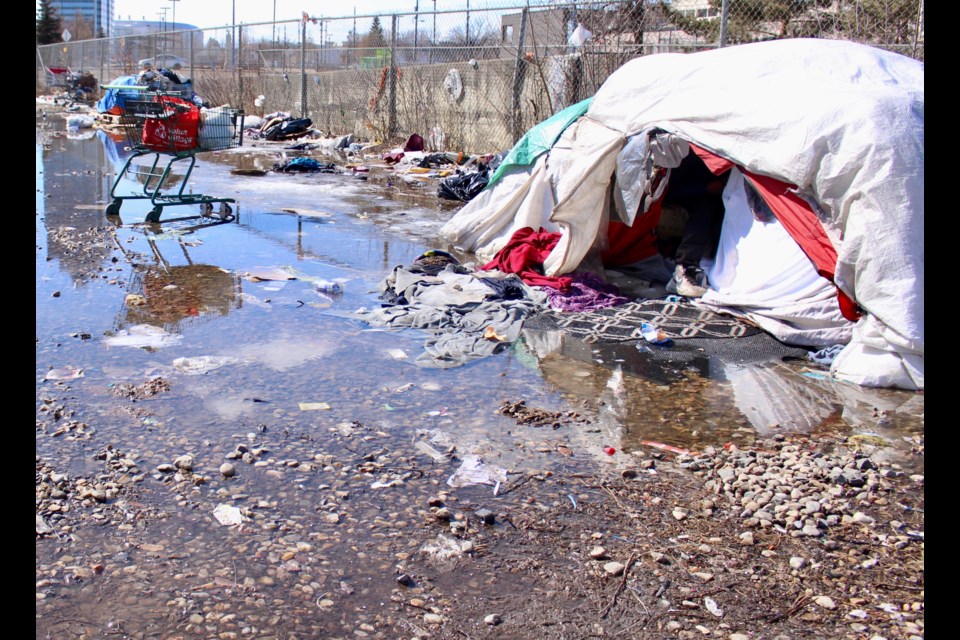Kevin King would rather live outside than go to the shelter set up at the Edmonton Expo Centre.
King, an Albertan who has been experiencing homelessness for the past three years, went to the centre two weeks ago and stood outside for an hour and forty minutes. He was bussed there with around 15 other people, and once they got inside, there was nothing to do: nowhere to charge his phone, no laundry facilities and limited access to showers and washrooms.
"We were just sitting there, waiting for lunches to show up," King told the Gazette.
He never went back.
Instead, he and around 40 others have set up tents in an area in Edmonton where they have no running water, garbage, bathrooms or food.
The people living there say they feel safer there than inside the Expo Centre. They worry about the cold and the outdoor living conditions, but there are fewer people and they have more freedom to move around.
Last Friday, as the snow was melting, many of the tents sat in puddles of water with garbage littering the area. Temperatures at night are still dropping well below zero and King and his friends are worried about freezing.
St. Albert NDP MLA and opposition critic for community and social services Marie Renaud and Edmonton-Highlands-Norwood NDP MLA Janis Irwin went to visit the people living in the area that day, trying to find ways to help them.“Obviously, community spread (of COVID-19) is a huge issue,” Irwin said.
“These guys are all overwhelmingly saying that it's safer to be here than at the Expo.”
Renaud held a press conference two weeks ago calling on the government to create safer living conditions for Albertans who are homeless during the pandemic.
At the Expo Centre, the provincial government has made arrangements for Albertans who are homeless to sleep on mats one metre apart from each other, alternating from head to toe in order to create more distance between their heads.
Irwin and Renaud said the people living outside in tents need garbage cans, food, toilets and water.
Renaud said as the people living outside in the tents don’t have access to life’s necessities, they would have to travel around the city looking for a place to find water and use a bathroom.
“They don’t have any way to get food, they don’t have any protection, they don’t have any way to practice good hygiene,” Renaud said.
Renaud said the government is doing its best, but it’s not enough and more needs to be done for individuals experiencing homelessness.
Alberta Community and Social Services Minister Rajan Sawhney has said the province decided to move forward with places like the Expo Centre because it wasn’t possible to quickly transfer 300 people from shelter into hotels and motels due to the work that would need to be done to retrofit the buildings for suicide prevention.
“Speed was a consideration,” she said.
“We needed to have the spaces put in place as soon as possible.”
In a press briefing, Alberta’s chief medical officer of health Deena Hinshaw explained the province is trying to weigh the risks to the homeless population and said she approved the one-metre exemption, which doubled the shelter capacity.
“It's trying to weigh out the risks to those individuals who need to use those shelters, with respect to transmission, and the risks of having them potentially out in the cold,” Hinshaw said, noting it could be dangerous to have individuals outside during this unusually cold spring.
“The people who are lying next to each other are not just one metre apart from one head to another, but they're actually further apart because of the diagonal distance between the two heads.”
In a press conference earlier this month, Renaud said cities like Vancouver and Toronto have found solutions to house individuals experiencing homelessness in hotels.
Renaud was joined in the press conference by housing advocate, president and CEO of BeTheChangeYYC, Chaz Smith, who said Albertans without homes should be housed in better conditions.
Smith said he wonders how Albertans experiencing homelessness will be able to stay far enough away from each other to safely practise social distancing.
“(There are) hundreds of individuals using the same washrooms, touching the same sinks, using the same toilets, touching potentially the same walls and areas,” Smith said of the Expo Centre.
“If one individual, if you can imagine, in such a dense population, were to get sick, how quickly that would transmit to each other.”




